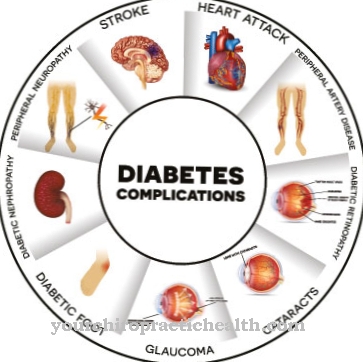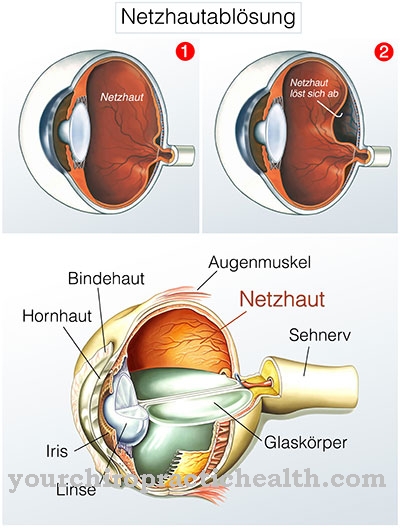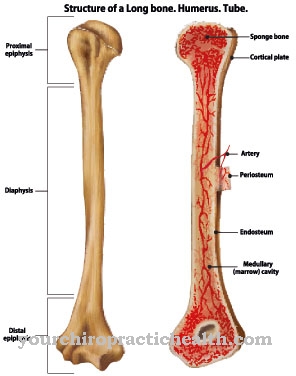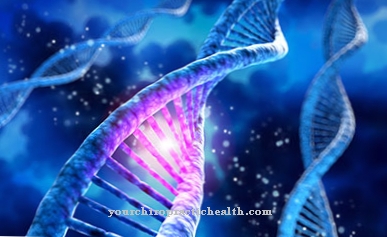The Buschke-Ollendorff syndrome is an inherited connective tissue disease. The rare disease affects the skeleton and skin. What effects does Buschke-Ollendorff syndrome have on the human body and how can the disease be treated?
What is Buschke-Ollendorff Syndrome?

© eranicle - stock.adobe.com
The Buschke-Ollendorff syndrome, which is also known under the Latin name of dermatofibrosis lenticularis disseminata, was named after the German dermatologist Abraham Buschke and the German-American dermatologist Helene Ollendorff-Curth. The rare connective tissue disease is a combination of a change in the skin and a change in the skeleton. Typical symptoms include osteopoicilosis or short stature.
causes
The very rare disease is genetic and therefore not entirely curable. The cause of this defect is a mutation of a chromosome on the LEMD3 gene. The so-called loss-of-function mutation takes place on this gene. This is understood to be a gene mutation that occurs in genetics. The consequence of this is a loss of function of the gene product concerned.
In Buschke-Ollendorff syndrome, the corresponding gene is instructed to produce a protein. The signaling pathways regulate various cell processes and cell growth. This also includes the growth of new bone cells. The mutation of the LEMD3 gene reduces the amount of functional proteins. Among other things, this can increase the density of the bone. There is no clear evidence of this research.
Symptoms, ailments & signs
The first symptoms can appear in any age category. The first signs are often recognizable in childhood, with the symptoms being different, both in the bones and on the skin. Most of the time, the skin changes are painless and grow over time. This feature occurs some time after the child is born.
These changes in the connective tissue are only a few millimeters in size and are mainly located on the hands and legs as well as on the trunk. Osteopoikilosis is a benign and accidentally discovered malformation in the bone. This bone malformation is only rarely diagnosed in adulthood. Small, round areas are visible in the bone that indicate increased bone density.
This can be seen in the X-ray image in the form of light spots. The malformations and skin changes usually do not resolve any complaints and the diagnosis is therefore very difficult to confirm. The Buschke-Ollendorff syndrome is diagnosed in the majority of cases by pure chance.
Diagnosis & course
In order to correctly diagnose Buschke-Ollendorff syndrome, further examinations are carried out in addition to a genetic test. A simple laboratory test is not enough for this disease of the human organism. The changes in the skin are confirmed by a histological finding. The skin lesions are examined microscopically by staining the tissue sections.
This diagnostic method can be used to detect abnormalities in the connective tissue of varying degrees. The elastic fibers and collagen fibers are particularly affected. These are responsible for the tensile strength of the fabric. The skin changes are in a small space and close together. The color is whitish to yellow and the shape is oval. The size is between that of a pea and a lentil.
X-rays of the hands and feet are taken to determine any changes in the skeleton. Since the lesions on the bones are mostly overlooked in childhood, these characteristics of the Buschke-Ollendorff syndrome are only discovered in old age. Typical bone changes are not noticed until the age of 15.
On the X-ray taken, increased and slightly thickened trabeculae, that is, small trabeculae on the bone, can be seen. These anomalies of the bone should not be confused with bone metastases or melorheostosis (thickening of the bone). If pain occurs, the Buschke-Ollendorff syndrome does not immediately follow.
Several complaints of the patient must come together in order to be able to include this hereditary disease in the diagnosis. If people suffer from joint swelling or frequent joint effusions, this does not mean that the examinations reveal the Buschke-Ollendorff syndrome.
Complications
In many cases, the Buschke-Ollendorff syndrome is diagnosed late, so that treatment can be delayed. This is because those affected usually do not experience any pain or other discomfort from the syndrome. Either malignant or benign malformations of the bones can occur.
As a rule, the diagnosis itself is made by chance during a check-up. In many cases there is also swelling or effusion on the joints. For the patient there are usually no further complaints or complications. For this reason, treatment of Buschke-Ollendorff syndrome is not necessary in every case.
Should there be any visible abnormalities on the skin, these areas can be treated. This is most often done with the help of medicines or ointments. This always results in a positive course of the disease without any further complaints or complications.
Diagnosis is often difficult, as the effects of Buschke-Ollendorff syndrome on the bones can only be seen to a small extent on the x-rays. Most often only young adults aged 15 and over are affected. Life expectancy is not influenced by Buschke-Ollendorff syndrome.
When should you go to the doctor?
In most cases, Buschke-Ollendorff syndrome is diagnosed in childhood. A doctor should then be consulted if the patient suffers from various changes on the skin. Although these are not associated with pain, they should always be examined by a doctor. This can prevent further complications. The growth of these skin changes can also indicate the syndrome. For this reason, the patient's bones should also be examined for changes.
The bone density itself is increased, which can be determined by an X-ray. An early diagnosis is important even if the children do not have any other symptoms or restrictions. The diagnosis can be carried out by a general practitioner or a pediatrician. Further treatment usually takes place with the help of ointments or tablets, so that no special doctor is required. The earlier the disease is diagnosed, the better the symptoms can be limited and treated.
Doctors & therapists in your area
Treatment & Therapy
In order to recognize Buschke-Ollendorff syndrome as such, the patient's family history is also of great importance. Not all sufferers have the same symptoms. When suffering from skin anomalies, there is not necessarily a bone anomaly and vice versa.
In general, the Buschke-Ollendorff syndrome does not cause any symptoms. However, to avoid incorrect treatment of the symptoms, a detailed diagnosis of the disease is necessary. The sooner the disease is correctly diagnosed, the sooner appropriate therapy can be started. If necessary, the skin anomalies are treated symptomatically at the affected skin area.
Treatment can be done with ointments or tablets. The right therapy method is individually adapted to the patient and the severity of the complaints. Appropriate medication is prescribed for severe skeletal symptoms. However, no cases are known to have assumed such severe proportions.
Outlook & forecast
A Buschke-Ollendorff syndrome cannot be treated causally. Only the individual symptoms can be treated and there is no complete healing.
As a rule, those affected suffer from various malformations, which can be of different severity. The further course and treatment of the disease also depend on these malformations, since surgical interventions are usually also necessary to alleviate them. Only the affected areas of the skin are treated symptomatically. There are no complications.
The earlier treatment of the syndrome begins, the higher the chances of a positive course of the disease. So far, there are no known serious cases of Buschke-Ollendorff syndrome in which the life expectancy of the person affected was reduced. Although patients are dependent on permanent treatment and use of ointments and medication in their lives, they are not or only very slightly restricted in their everyday life.
Pain does not occur on the skin. Changes to the skeleton can also be corrected, although these are usually only recognized at a young age.
prevention
Since Buschke-Ollendorff syndrome is a difficult to recognize disease, it is not easy to assign symptoms correctly. Since it is a genetically inherited disease, it cannot be counteracted. The probability that a disease is in the gene is very small.
With around 20,000 births worldwide, on average only one person suffers from Buschke-Ollendorff syndrome. Even if the hereditary disease is diagnosed, it does not affect life expectancy. The patients have a good health prognosis and modern medicine can completely contain any symptoms that may arise. At the first signs of the disease, extensive diagnostics are necessary.
Aftercare
As a rule, those affected with Buschke-Ollendorff syndrome have no direct options for follow-up care. The disease can only be treated symptomatically and not causally, so that the affected person is mostly dependent on lifelong therapy. This can also lead to a reduced life expectancy.
Since Buschke-Ollendorff syndrome is usually treated with the help of tablets, creams or ointments, those affected must ensure that they are taken or applied regularly. Possible interactions with other drugs should also be considered and discussed with a doctor.
As a rule, the symptoms do not restrict the person affected particularly much, so that the patient can live an ordinary life. Likewise, no particularly severe proportions of the Buschke-Ollendorff syndrome are known. Since the Buschke-Ollendorff syndrome can in some cases also lead to psychological complaints or depressive moods, a psychologist should be visited in these cases.
However, talking to friends or family can also be helpful in avoiding such discomfort. Furthermore, in the case of Buschke-Ollendorff syndrome, contact with other sufferers of the syndrome is also helpful, as this can lead to an exchange of information.
You can do that yourself
Buschke-Ollendorff syndrome can now be treated well. The patient can additionally support the recovery by observing strict personal hygiene and caring for the affected areas according to the doctor's instructions.
It is also important to use the prescribed care products. The medicinal ointments and lotions must be applied regularly, especially in the area of skin changes, in order to promote wound healing and prevent scarring. The patient should also avoid exposure to sunlight and skin contact with harmful substances. This can be achieved, for example, by wearing suitable clothing. People who expose their skin to great stress at work should consider changing jobs.
In addition, regular checks are part of the necessary self-help. Anyone who notices unusual places in other parts of the body or is allergic to the prescribed remedies should inform their doctor. The doctor can often give further tips on how the patient can support the treatment. First and foremost, rest and rest are important so that the body can sufficiently recover. Depending on the cause of the syndrome, further measures may be useful, which those affected can discuss with their family doctor.

























.jpg)

.jpg)
